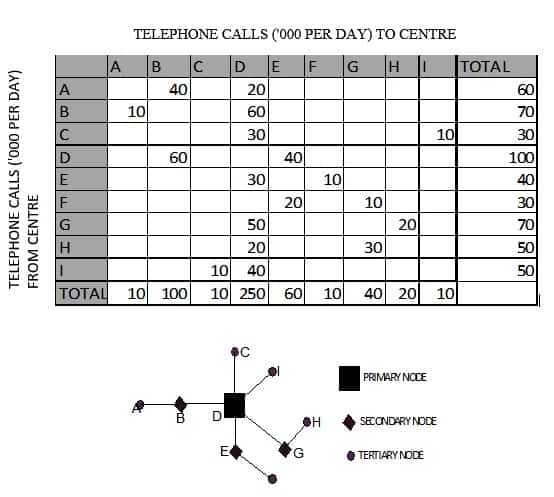Delineation Of Functional Regions iis done by using any of the 2 most widely used methods: These are:
- Flow Analysis
- Gravitational Analysis
Both the methods are explained below:
Flow Analysis Method – Functional Region Delineation
Flow analysis builds up functional regions on the basis of the direction and intensity of flows between the dominant centre and surrounding satellites. Each flow will show decreasing intensity as it becomes more distant from the main centre and increasing intensity as it approaches another centre. The boundary of the sphere of influence of the dominant centre will be where the flow intensity at a minimum. When the flow significantly drops that means interaction/origin’s influence drops. In terms of distance, in a particular direction, there is the influence of the node and there onwards it drops. This gives cut off points. Tentative delineation is done.
Features of Flow Analysis Method
- Builds up flows on the basis of the direction and intensity flows between the dominant center and surrounding satellites.
- Flows may be of several types: economic (road, rail, shopping or commuting); social (such as flow of students or patients); political (flow of govt. expenditure); information (newspapers, telephone calls), etc.
- Graph theory: measures the relationship (economic, social, etc) between selected group of centers on the basis of flows between the centers. The no. of telephone calls is the usual flow criteria.
- The flows are plotted in matrix form, from which primary and secondary flows into and out of each center can be identified.
The flows may be of several types
- Economic – cargo or passenger, road or rail
- Purpose – shopping or commuting
- Social – flow of students or hospital patients
- Political – flow of govt. Expenditure
- Information- telegrams, newspapers and telephone calls.
Illustrative example using Flow Analysis Method

The no. of telephone calls is taken as the flow criteria. The flows are plotted in matrix form, from which the primary and secondary flows into and out of each centre can be identified. The resulting hierarchy of nodes can plotted as a simple network, providing an insight into the form and extent of functional relationships within an area. Here D is the major centre, with B.E and G subsidiary centres.
B. Gravitational Analysis Method
It is concerned with the theoretical forces of attraction between centres rather than actual flows. The gravity model assumes that the interaction between two centres is directly proportional to the ‘mass’ of the centres and inversely proportional to ‘distance’ between the centres.
- ‘Mass’ can be population, employment, income, expenditure and retail turnover.
- Distance can be in physical terms (kms), time, price, and intervening opportunities.
- In mathematical notation f = k (m1 * m2)/d
Where f is the force of attraction between two settlements, m1 and m2 are masses of the two settlements and d is the distance between them. K is a constant.
Features of Gravitational Analysis Method
- It is concerned with the theoretical forces of attraction between centers rather than the actual flows.
- This model assumes that the interaction between two centers is directly proportional to the ‘mass’ of centers and inversely proportional to the ‘distance’ between them.
- ‘Mass’ is represented by variables like population, employment, income, expenditure and retail turnover.
- ‘Distance’ is represented in physical terms (miles), time, price and intervening opportunities.
- Mathematically
- By calculating the potential for the centers, lines illustrating relative attractiveness, spheres of influence of various centers can be plotted on a map.
- From such lines, functional regions can be identified.
Concept of Demographic or Gravitational Potential
The demographic potential at centre ‘i’ caused by a mass centre j (jvi), is defined as
ivj = k (mj)/dij
By calculating potential for the centres in a study area, contour lines of equal potential can be plotted on a map, illustrating the relative attractiveness, spheres of influence, of the various centres. From such lines, functional regions can be identified.
Illustrative Example- Delineation of National Capital Region
To delineate boundary of NCR, study was done for a region of radius of 110 km around Delhi. which included 42 tehsils.

The demographic criteria adapted at the time of NCR delineation were
- Population growth rate
- Level of urbanization
- Economic activity (% of non-agricultural workers)
- Migration
- Density of population
- Population
Minimum benchmarks were set for each criterion and tehsils which fulfilled ≥2 were included in initial delineation.
Flows considered at the time of delineation of NCR:-
- Volume Of railway good traffic
- Volume Of road good traffic
- rail/road passenger traffic
- Wholesale trade in terms of money value
- Supply of raw materials to industry
- Supply of labour
- Sale of finished goods
- banking facilities
- Supply of perishable goods
- Cultural affinity (newspaper circulation, telephone calls, telegraphs etc.)
Dependency of services considered at the time of delineation
- Water supply
- Solid waste disposal
- Power etc.
Also read about: Delineation of Formal Regions, Population Projection & Forecast